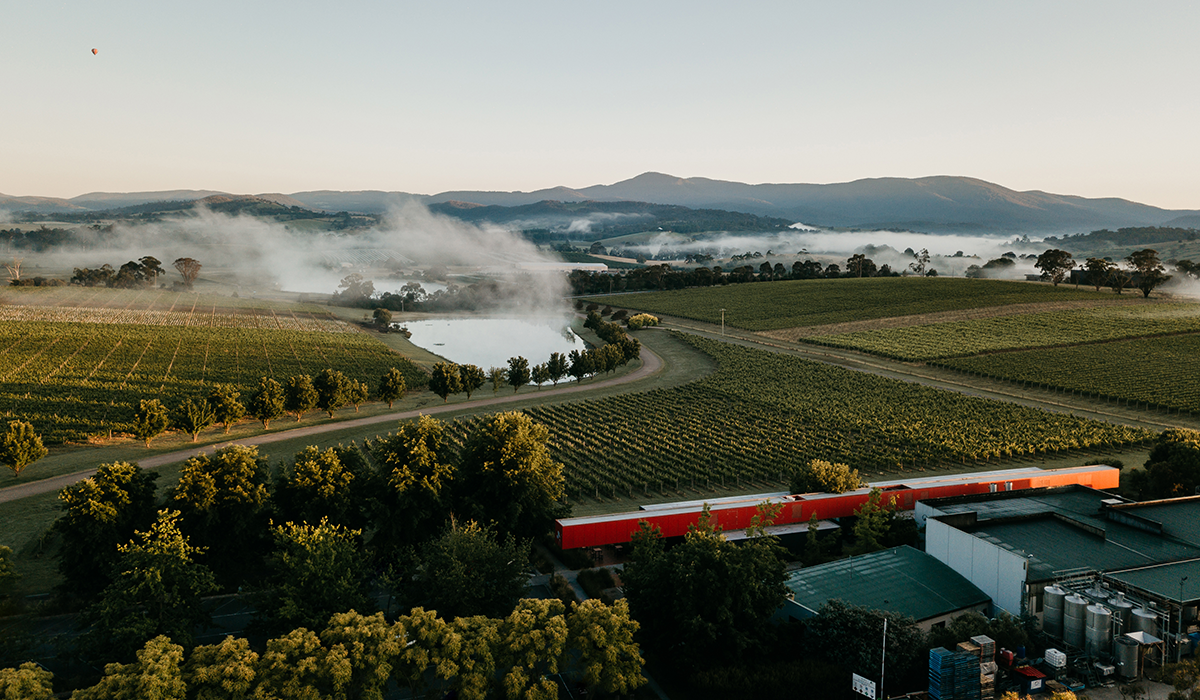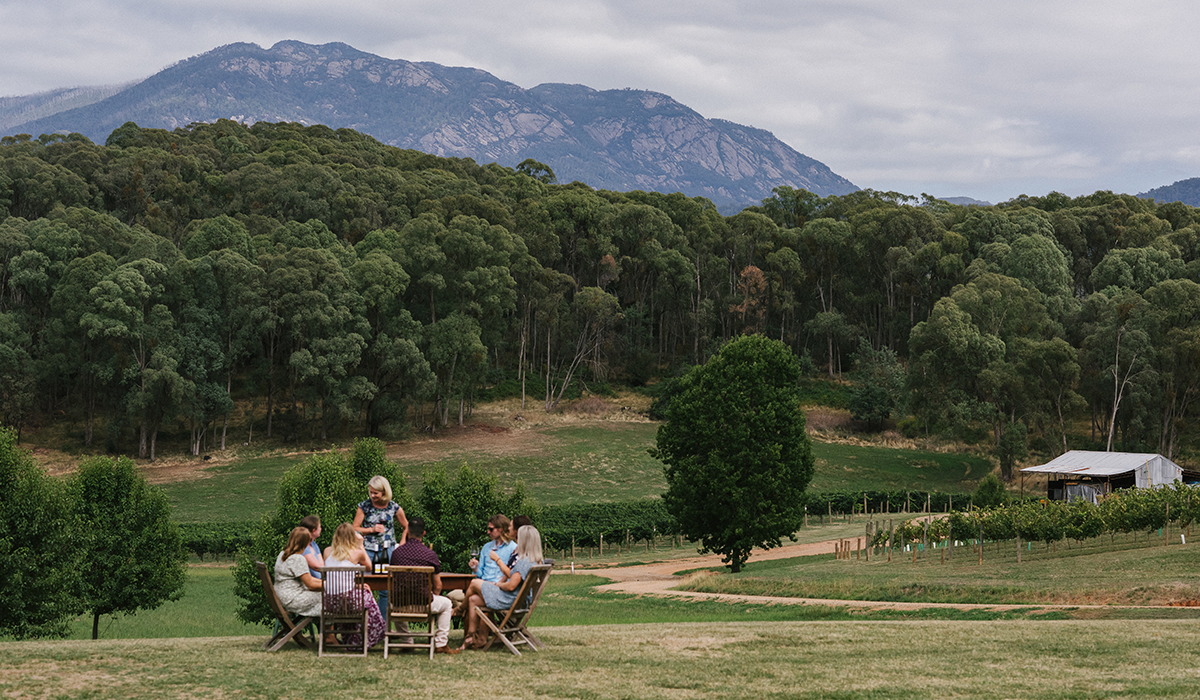The 2023 Victoria vintage
The 2023 vintage in Victoria was not without its challenges with La Niña delaying vintage in some regions and most experiencing very wet weather late into the year. The standout varieties in the Pyrenees were arinto, chardonnay and pinot noir. Rutherglen experienced the flooding through the Murray River system, which meant access was lost to vineyards in the region.
The Yarra Valley had the wettest August and October on record, and La Niña made sure September and November didn’t let up until Christmas was approaching. High rainfall, warm nights and high humidity lead to very high downy mildew pressure and resultant significant crop losses. But more was to come. Wind and rain upset flowering and low bud fruitfulness (a legacy of a year ago) all contributing to low bunch weights at harvest. But the new year heralded a total change in the weather: blue skies, low humidity, 25°C daytime temperatures and no heat spikes gave birth to grapes with modest baumes, perfect acidity and high concentration of varietal flavour. One respondent suggests that
pinot noir and
chardonnay could rival the great ’22 and ’21 vintages. For later ripening varieties it will be a year of perfume and elegance.
The Mornington Peninsula pointed to the third La Niña in a row reducing yields by 50 per cent, yet harvest didn’t start until three to four weeks later than the new normal. Pinot noir is the standout with lovely depth of flavour and of intensity.
Gippsland had the patented 2023 climate outcome of two halves and a Delphic comment ‘excellent for the fruit picked’ of chardonnay, pinot noir and
shiraz.
 Oakridge Wines in the Yarra Valley.
Oakridge Wines in the Yarra Valley.
The Alpine Valleys and King Valley had many things in common: a very late start to vintage (La Niña); dreadful weather until December; good from February onwards; yields all down – the only question which suffered least; quality also variable, but highlights different. The Alpine Valleys standouts were sparkling pinot noir, chardonnay (all purposes), shiraz, albariño and
cabernet sauvignon. The King Valley highlights red wines (cool nights, sunny days, perfect ripening) and extremely high quality
prosecco (high natural acidity, moderate yields).
Beechworth was cool and wet all the way, low to moderate yields, chardonnay and pinot noir the standout varieties; others not picked as at mid-April.
Upper Goulburn’s wet, cold spring smashed fruit-set, but mid-summer surprised with warm and even ripening conditions and high quality riesling,
pinot gris and gewürztraminer.
Geelong reported one item of good news: the vineyard dam was full for the first time since 2011! Pinot noir produced 40 per cent of average yields, chardonnay 70 per cent, and quality was described as good across the board rather than great.
Ballarat, Henty and reprise of Geelong from one reporter with fruit sources elicited the comment: ‘For the third season in a row significantly cool conditions have led to a waiting game whilst we rolled the botrytis dice,’ with yields all over the place and also ‘a miserable year for pine mushrooms in Ballarat!’ Chardonnay is the standout variety, he continues, ‘While the wines will be ethereal rather than concentrated in style, they will fully translate the growing season and country they were grown in.’ Henty was a ritual slaughterhouse for all except
riesling.
 Anderson and Marsh in the Alpine Valleys.
Anderson and Marsh in the Alpine Valleys.
The Macedon Ranges had marvellous weather after a chaotic spring. Yields were normal, and chardonnay has fine acidity, pinot noir with excellent colour and phenolic ripeness. Finesse and latent power are the watch words.
Bendigo followed the mainstream: miserable weather, yields low to very low, growers losing 30–100 per cent of their crop, the bright spot – shiraz. Overall quality was described by one reporter as, ‘what hit the winery deck was great. There was just very little of it.’
Heathcote conformed with attention to detail in the weather taking on a new meaning, but one distinguished winemaker said the wines ‘look very promising at this early stage, quite elegant and finely balanced with lovely detail and presence, reminiscent of ’17 and ’14; shiraz the standout.’
The Grampians had a subvariant of weather, most notably most varieties having greater yields than ’22, and the best quality rosette going to riesling, pinot noir and pinot meunier.
 All Saints Estate in Rutherglen.
All Saints Estate in Rutherglen.
Nagambie Lakes, however, had an even more horrific time of it. Tahbilk’s property is 1215ha, and of the 195ha that is vineyard, 93ha was submerged by the flooding of the Goulburn River (including the 32ha of vines planted between 1860 and 1969). The farmer 1874 in Alister Purbrick says, ‘overall, we are extremely happy with the result despite the volumes being quite low. We estimate that vineyard yields will be around 60-70 per cent below normal expectations.’
The Strathbogie Ranges is home to
Fowles Wines, which sits on top of a hill in the region, and even it was flooded. One of its irrigation dams burst and the Fowles team had to repair the breach within five days before the next bout of forecast rain. Bogging of tractors became routine, keeping stress levels all too high. After December, still cold and wet, there were heavy localised rain events, but overall conditions were sufficiently dry to ripen the white varieties and pinot noir, the fuller-bodied reds not picked until the very end of April. ‘A cracking
sauvignon blanc, chardonnay, riesling and vermentino year, with great fruit intensity.’ And, most surprisingly, yields in line with historical average.
In the Pyrenees a supposed end to La Niña set the expectations of a return to warm and dry weather, but instead it was cold and wet, which delayed ripening by many weeks. The reds were close to average yield, but the whites were well below, the standout varieties being arinto, chardonnay and pinot noir.
Glenrowan’s vintage intake was delayed by three weeks; the cool, wet season creating higher disease pressure, impacting on a lower than average yield. A respected winemaker says, ‘shiraz, which is the region’s signature variety, clearly demonstrates how insightful our forebears were’.
The well-publicised flooding through the Murray River system meant access was lost to vineyards in Rutherglen, some parts totally underwater for weeks. Harvest started on March 1, but took some time to gain momentum and still going on into May. Yields were impacted accordingly, down 30–90 per cent. Quality is, of course, variable, however there are gems such as chardonnay, shiraz and
muscat, picked just before the Easter rain.
Top image credit: Wine Australia.